


Most magicians and many visual effects artists prefer using dusts or powders to create explosive flame effects because their unburned residues are so safe, some are even edible, that unlike flammable liquids and gases there are no environmental safety issues. Flammability dangers are greatly reduced because the powders can only ignite when they are dispersed in the air. Piles left on the ground will not ignite and can even put out fires. This is not to say they are harmless. Any fire is dangerous. But the dusts and powders used are not intrinsically dangerous, which makes them extremely attractive. They also offer an increased variety of effects because they can be colored and sculptured more easily than flammable liquids.
Dusts and powders can explosively ignite when they are dispersed in air because they have such a high total area exposed to the oxygen in air that combustion is easily initiated and maintained. A popular analogy is comparing three equal sized logs prepared in three different ways to be burned. The first is left in one piece and is very difficult to start burning. The second log is split into many pencil-size sticks. It readily ignites and burns. The third is ground into sawdust. If thrown into the air where all the dust-sized pieces are exposed to oxygen it can burn so fast its combustion resembles an explosion.
For the home experimenter and the educational demonstrator, the important question is: "Which dusts or powders produce the best fireball explosions?" This page compares ten commonly available materials to see which work the best. Visitors preferring a live action version of this page may view it at:
However, this written webpage provides additional details not available in the video.
All the following tests used one-half teaspoon of powder placed in a brass elbow connected to a length of half-inch diameter vinyl tubing. In each test a fire starter is held in as close to the same position as possible and the same amount of breath used to blow into the tube to exhaust the dust into the air. The air temperature was 90-degrees and the relative humidity was 20-percent. There was no appreciably wind.
Lycopodium Powder:
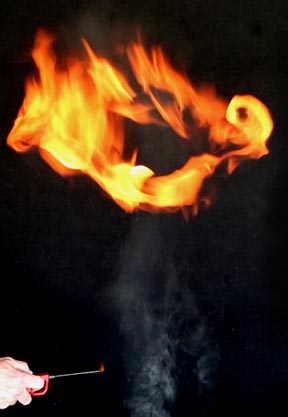
Lycopodium powder, the spore of the lycopodium plant, is the preferred flammable dust employed by magicians all over the world. It is a light yellow, free flowing, non-clumping powder that ignites and burns easily. It's only drawback is that at $30.00 per ounce it's very expensive compared to most alternatives. It is considered the best fireball explosive material in common use. The sequence of images at the top of this page are of a lycopodium fireball.
Powdered Sugar:
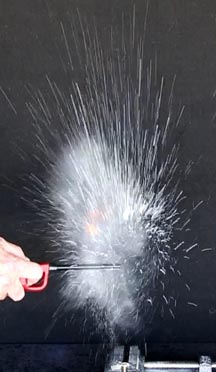
At first appearance it may look like the powdered sugar completely failed to ignite. However, careful examination of the area slightly above and to the left of the fire starter's tip reveals a dim orange glow suggesting some ignition occurred. However, the results so minimal that powdered sugar under these conditions has to be considered a poor material.
Cake Flour:
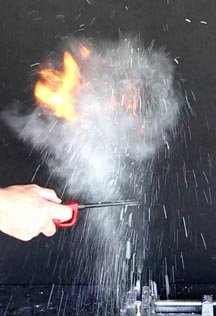
In the video it appears as if the cake flour fails to ignite. A frame-by-frame examination discloses that it did catch fire, though only briefly. Like powdered sugar, this is not a good candidate.
Whole Wheat Flour:

This one not only didn't burn, it put out the fire starter.
Corn Starch:
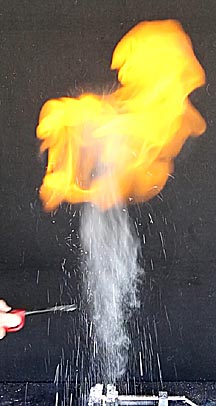
Corn starch produced the second best fireball.
Cinnamon:
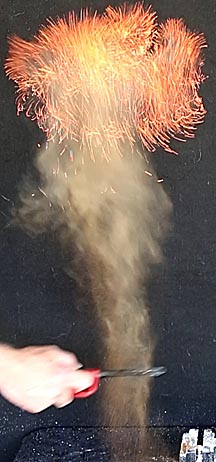
Cinnamon is a spice made by finely grinding the bark of any of certain laurel trees. It produces longer lasting sparks that create an attractive effect. However, it fails to produce the explosive burst of fire desired for most special effects. It would be interesting to see what a fifty-fifty mix of cinnamon and lycopodium would look like.
Vanilla Pudding Mix:
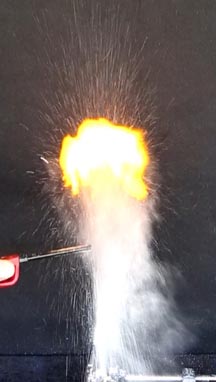
While it created a modest fireball, vanilla pudding mix performed poorly compared to lycopodium powder or corn starch.
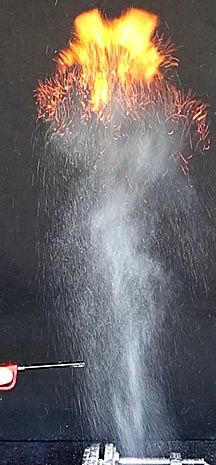
Coffee creamer is a popular dust fireball explosion material for YouTube videos, and it's easy to see why. Not only does it produce the third best fireball, it also has sparks like cinnamon.
Sawdust:
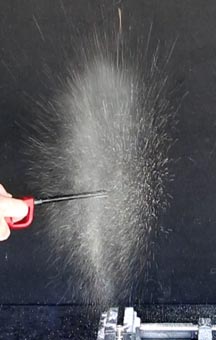
Sawdust was the only other material that actually extinguished the fire starter. This surprised me because I've watched several YouTube videos where it produced very large fireballs.
Charcoal Briquet Dust:
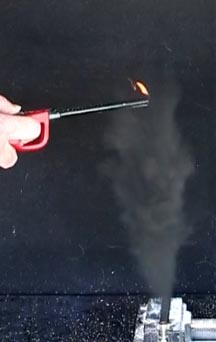
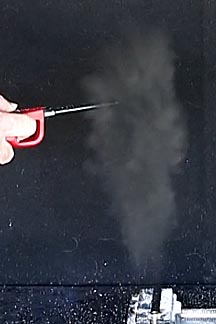
This one surprised me. I anticipated that charcoal dust would ignite and burn with a vengeance. Instead, it only increased the fire starter's flame slightly before extinguishing it. This is actually good because it's messy to make and clean up.
Natural Wood Charcoal Dust:
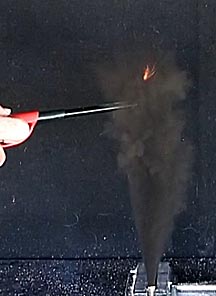
It performed the same as the briquet dust, though in this case the flame carried upward slightly longer and contained more of a spark-like appearance.
Freeze-Dried, Finely-Ground Bloodworms:
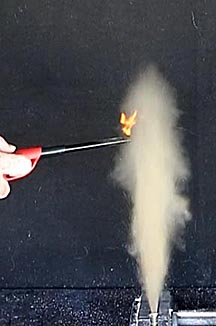
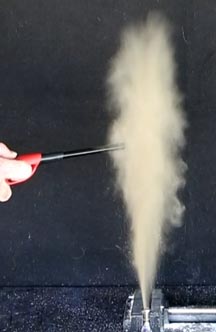
This may sound like a ridiculous material to test, but I had good reasons to do so. I keep it to feed to my collection of Venus flytraps. In composition it is very finely ground powder, which, like lycopodium powder and coffee creamer, is very free flowing. I assumed it might work well. I assumed wrong. I believe the problem is that its high fat and complex protein structure prevents it from burning rapidly. It ignites, but isn't self sustaining.
Conclusions and Analysis:
These tests suggest that lycopodium powder, corn starch and coffee creamer are the best materials for creating dust fireball explosions. Cinnamon deserves credit for producing many discrete sparks.
Two questions remain: "Why does lycopodium powder work so well" and "Why didn't these tests produce good fireballs from materials that have been reported to perform well?"
I believe the following image offers possible answers to both questions:
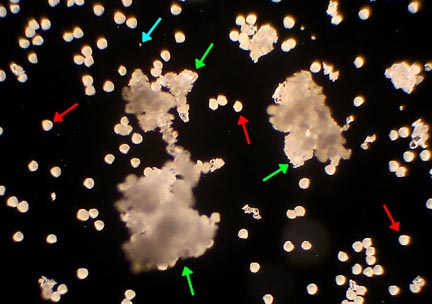
This is a 100X image of lycopodium spores and cake flour. While individual grains of cake flour (cyan arrow) are much smaller than lycopodium spores (red arrows) and would be expected to burn faster because they expose a larger relative surface area to the air, flour grains tend to form clumps (green arrows) which significantly reduce surface area. Additionally, these clumps resist being broken up. This can best be seen in the picture of the powdered sugar test,

which shows that much of the material produces persistent clumps that create solid streaks in the image. I believe this is why some of these tests didn't produce the sorts of fireballs reported for these materials. Those demonstrations use more powerful methods of dispersal that were strong enough to knock the clumps apart.
The following video shows the results of tested a few more dust fireball materials:

Producing
dust fireballs is a challenging and interesting exercise. But, it
must never be forgotten that because it deals with fire, one of the
most dangerous of all natural phenomenon, the following statement
should be respected:
THE
DEMONSTRATIONS ON THIS PAGE AND IN ITS ASSOCIATED VIDEO ARE EXTREMELY
DANGEROUS. NO
ONE SHOULD EVER ATTEMPT THEM. DOING SO COULD RESULT IN
FIRE THAT
COULD DESTROY PROPERTY, CAUSE SERIOUS INJURY AND DEATH.
Having said that, I sincerely hope you enjoyed this page. Thank you for visiting.
Return to my main page to browse 60 other subjects